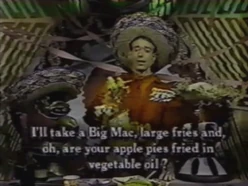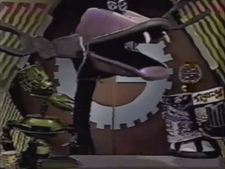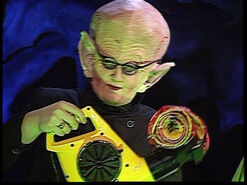| “ | "Remember that bad thing we saw? It looked just like this. This is bad." | ” |
The movie
- Main article: The Black Scorpion (film)
While investigating a recently formed volcano in Mexico, two geologists encounter a prehistoric scorpion which had been freed from its underground habitat.
The episode
Host segments

An SOL tribute to Mexico
Prologue: The Bots throw a party for Joel.
Invention Exchange: A lab accident with a "cold fusion Walkman" mutated Dr. Erhardt into an alien-type creature, while Dr. Forrester becomes a skeleton. Joel makes a giant party favor powered with a leaf blower. Dr. Erhardt starts to show their invention before realizing it's exactly the same thing as Joel made. Forrester tries to soften the blow by claiming their invention was actually a salve to cure their "condition".

Gypsy as a scorpion
Segment Two: Joel and the bots present a madcap tribute to Mexico, with them speaking in dubious Spanish with highly suspect English subtitles for translation.
Segment Three: Crow and Tom discuss human nature, unaware that Gypsy has become a scorpion monster.
Segment Four: Crow and Tom put on a puppet show and discuss stop-motion animation, correcting the earlier mistake regarding Ray Harryhausen designing the effects when it was actually his mentor, Willis O'Brien.

A mutated Dr. Erhardt
Segment Five: Letters (one of which contains several backhanded complements for Crow) are read.
Obscure references
- "It's Krakatoa, east of Java."
- Krakatoa was a volcano in Indonesia that exploded in 1883, causing the island to disappear. It is referenced with the lyric "Krakatoa, East of Java" in the B-52s song "Lava".
- "Look it's Arne Saknussemm"
- Arne Saknussemm was an explorer in Journey to the Center of the Earth by Jules Verne.
- "And there, on the handle, was a hook!"
- The last line from a popular campfire story and urban legend sometimes called The Hook.
- "Hey, it’s Krakatoa, east of Java. Fentonville, east of Muncie."
- Krakatoa, East of Java is a 1969 film about the catastrophic eruption of the volcano Krakatoa in 1883.
- "Wow, is that a crackhouse or what? –Cops is filmed on location. Everything you see is true."
- Cops is a long-running reality TV show about real police officers in real situations; it first aired in 1989.
- "Hey, it’s Universal Studios."
- Universal Studios was founded in 1912 by Carl Laemmle and is one of the oldest studios still in operation.
- "Let’s make s’mores later."
- S’mores are a favorite campfire snack, consisting of a toasted marshmallow and a square of chocolate (ideally Hershey’s) sandwiched between two halves of a graham cracker.
- "Edmund Fitzgerald? This must be his wreck. –Edward. –Ah."
- The SS Edmund Fitzgerald was a freighter that sank in Lake Superior in 1975, taking all 29 crewmembers with her. The event was immortalized in the 1976 Gordon Lightfoot song "The Wreck of the Edmund Fitzgerald".
- "[Imitating Bing Crosby.] Now, Junior, we’re just looking for a place to picnic here. I know Gary’s buried around here someplace. Look around for that shallow grave."
- Harry Lillis "Bing" Crosby (1903-1977) was a singer and actor best known for hits like "White Christmas" and a series of "Road" films with Bob Hope. Gary Crosby (1933-1985) was Bing’s oldest son who, six years after his father’s death, published the autobiographical Going My Own Way (1983), which detailed his mother’s alcoholism and father’s emotional and physical abuse. Two of Gary’s brothers, Lindsay and Dennis, confirmed the account; they both killed themselves several years later.
- "Hey, why does he need a pipe? Why doesn’t he just suck in some air? –Feel the pumice power work on your lungs."
- Lava soap is a heavy-duty hand cleaner originally developed by the Waltke Company in 1893. Currently, it’s manufactured by WD-40. Lava contains ground pumice to act as an abrasive in cleaning the skin, and brags that it is "specially formulated with pumice power."
- "Looks like it’s from the old M*A*S*H set."
- M*A*S*H was originally a 1968 novel by Richard Hooker that became an acclaimed 1970 film by Robert Altman. This then became the hugely successful TV series that ran from 1972 to 1983.
- "Wait, that’s my motorman’s helper."
- Motorman’s Helper is the name given to a receptacle used by long-distance drivers to relieve themselves in case an actual rest stop can’t be found.
- "Meanwhile, on a pole somewhere."
- The phrase, "Meanwhile, back at _____," originated with cards inserted in silent films of the early 20th century. In westerns, this was often "Meanwhile, back at the ranch ..." Once audio became a common component, the phrase was still used by narrators for films and radio and television shows.
- "[Sung.] Two bottles of beer in the Jeep, two bottles of beer. Take one down, pass it around ..."
- A paraphrased portion of the song "99 Bottles of Beer on the Wall," a popular English folk song sung in declining numerical order as each bottle is taken down and passed around.
- "Wow, it’s a car. That looked like a cool Ford. –Yeah, it’s a ‘55 Ford. With a little work, it could be cherry. We chop it, drop it, add some Thrush pipes. It’ll be great."
- Ford Motor Company is one of the world’s oldest automakers, founded in 1903 by Henry Ford. Thrush is a maker of automotive parts, primarily mufflers. They’ve been in business since 1966.
- "Hey, look back here. There’s a key light."
- In movie-making photography (cinematography), the key light is the primary light used to illuminate the scene.
- "The Schlitz Malt Liquor Bull. –The wild-eyed beast. –The grass eater."
- Schlitz Malt Liquor was introduced by the Joseph Schlitz Brewing Company in 1963. It’s well known thanks to the image of a large blue bull (named Prince) on its cans, as well as commercials in the 1980s and ‘90s with a live bull (named Zane) breaking into homes to party, one presumes.
- "What’s behind this tree? It’s a dead cop! –That’s right, Bob, it’s a 1953 seniora policia, complete with a .38 snub-nose revolver, dilated pupils, and rigor mortis. You, too, will sleep silently in seniora policia. –From Spiegel catalog, Chicago, Illinois, 60609."
- An imitation of game show announcers, most likely addressing The Price Is Right host Bob Barker. Spiegel is a catalog company that was started by German immigrant Joseph Spiegel in 1865. During the 1970s, they provided many prizes for game shows, and the announcer would plug the prizes by saying, "Spiegel. Chicago, 60609."
- "I told him not to eat the worm."
- A reference to the myth that worms are sometimes found at the bottom of tequila bottles.
- "The San Lorenzo Milling Around Festival! –Hey, G.I. Joe, number one! –Hey, mister, my sister boobly-oobly! –Chocolate? Eh?"
- "G.I. Joe" is a slang name for U.S. soldiers around the world, predating the famous toy lines created by Hasbro and dating back to World War II. ("G.I." means "Government Issue," not "General Infantry.")
- "What’s that, muchachos? Death trap? Dead Rock Canyon?"
- A paraphrased exaggeration of "dialogue" between Lassie the Collie and any one of several human characters from the 1947-1950 radio series, the long-running television series (1954-1973), two sequel series, an animated series, and eleven films.
- "You know, Gary talked to me that way once. Once."
- A reference to the 1984 comedy gangster film Johnny Dangerously, which starred Michael Keaton in the title role as a charming mobster and Joe Piscopo as his psychotic antagonist, Danny Vermin. A runing gag involved Danny uttering lines like, "You shouldn’t hang me on a hook. My father hung me on a hook once. Once."
- "Amen to that, Sluggo. I mean Father Sluggo. Padré."
- Possibly a reference to the character Sluggo Smith in the long-running comic strip "Nancy." The diminutive, shaven-headed boy was introduced in 1938. It could also refer to the clay antagonist of the Saturday Night Live character Mr. Bill. "Mr. Bill" was originally a short film submitted by New Orleans DJ Walter Williams in 1976 when the show asked for home movies. The sketch proved wildly popular, and the characters returned more than twenty times; Williams was hired as a full-time writer for SNL from 1978-1980.
- "It’s the Cisco Kid!"
- The Cisco Kid was created by O. Henry in the 1907 short story "The Caballero’s Way." In this tale, he is an outlaw who kills and robs along the Texas-Mexico border. However, when the character was adapted for other media, he became a hero. The first of twenty-seven films (six of which featured Cesar Romero in the title role) was released in 1914; the last in 1950. In 1942, a radio series began that ran for more than 600 episodes before its end in 1956. A television series—the first to be produced in color—ran from 1950-1956. Comic strips and comic books were published off and on between 1944 and 1967. In 1972, the band War released a popular song titled "The Cisco Kid." The character hasn’t done much of anything since the western genre petered out except for a 1994 TV movie starring Jimmy Smits as the title character and Cheech Marin as his sidekick, Pancho.
- "Hey, it’s Dale Evans, and I thought she was stuffed. –Mounted."
- Dale Evans (1912-2001) was an actress, singer, and the third (and last) wife of singing western star Roy Rogers (1911-1998). She co-starred with Rogers in more than two dozen films and in NBC’s 1951-1957 The Roy Rogers Show (a 1960s version of the show didn’t last very long). In 1953, she published a book titled "Angel Unaware", which was about her and Roy’s daughter Robin, who died before the age of two from complications related to Down’s Syndrome. Her openness and advocacy changed public attitudes toward the mentally disabled. Roy Rogers’ famous horse, Trigger, is frequently thought to have been stuffed after his death in 1965. In fact, a plaster likeness was made and his preserved hide was stretched over it. In taxidermy, this is known as "mounting." Trigger was on display in the Roy Rogers and Dale Evans Museum, first in Victorville, California, and later in Branson, Missouri, until it closed in 2009. In case you’re wondering, Dale’s horse was named Buttermilk; he was also mounted and displayed at the museum after his death.
- "That’s the same place where they filmed Robot Monster."
- Robot Monster is a 1953 science fiction film often regarded as one of the worst films ever made, featuring, as it does, a man in a gorilla suit with a skull mask wearing some sort of diving helmet while destroying the world with a bubble machine. It was featured in Experiment #107.
- "The weather started getting rough. The tiny ship was tossed."
- A couple of lines from "The Ballad of Gilligan’s Isle," the theme song of Gilligan’s Island, the 1964-1967 CBS sitcom. It was written by Sherwood Schwartz and George Wyle. The first season version was performed by The Wellingtons; later seasons were sung by The Eligibles.
- "Are those foam hats? I told you to wear mouse ears."
- Presumably a reference to the mouse-ear hats originally worn by the Mouseketeers on The Mickey Mouse Club, which first aired in 1955. The hats were designed by Disney artist Roy Williams, who also played "Big Roy," the adult Mouseketeer on the show. They are sold at the Disney theme parks, with space for the child’s name to be embroidered on the back, and now come in a dazzling array of varieties and colors other than basic black.
Behind the scenes
MST3K cast
Regular cast
- Joel Hodgson - Joel Robinson
- Trace Beaulieu - Crow T. Robot / Dr. Clayton Forrester
- Josh Weinstein - Tom Servo / Dr. Laurence Erhardt
- Jim Mallon - Gypsy
- Jann Johnson - Magic Voice
MST3K crew
Production
- When introducing the film, Dr. Forrester states that the effects are by Ray Harryhausen. They are, in fact, by Harryhausen's mentor, Willis O'Brien and animator Pete Peterson.
- The scorpion/spider model that appears in Host Segment Four is made from a Masters of the Universe Spydor toy. The box for this toy (presumably the same one) was later used for the Freak Out kit in Experiment #410 (as revealed in the first Poopie! volume).
Goofs
Movie Edits
As with most of the riffed movies, The Black Scorpion was altered to fit the TV format and had several scenes trimmed to fit within the desired time-slot. Removed footage from this film includes:
- Scott, Ramos, and Father Delgado discussing the villagers' superstitions regarding the "demon bull." Delgado mentions that several workmen from Teresa's ranch have fled to the town due to the rumors. Teresa later accompanies Scott and Ramos back to the town to convince the workers to return.
- After Scott and Ramos fly back to meet with Dr. Velazco, the first few minutes of their meeting was cut, in which it is revealed that a giant scorpion has been photographed near a major city.
Callbacks
- "Scorpions like this always have lots of ice cold beer around." (The Crawling Hand)
Video releases

MST3K DVD Cover
- Commercially released on DVD by Shout! Factory in July 2014 as part of Volume XXX, a 4-disc set along with Outlaw, The Projected Man, and It Lives by Night.
- The DVD includes the Ballyhoo Motion Pictures feature Stinger of Death: Making The Black Scorpion and a theatrical trailer.
- Digitally available through Shoutfactorytv.com, Rifftrax, Amazon Instant Video, iTunes, Vudu, and VHX.
Gallery
References
| preceded by: Season K | MST3K Season 1 | followed by: Season 2 | ||||||
| 1989 - 1990 | ||||||||
| 101 | The Crawling Eye | 1989-11-25 | 106 | The Crawling Hand | 1989-12-16 | 111 | Moon Zero Two | 1990-01-20 |
| 102 | The Robot vs the Aztec Mummy | 1989-11-18 | 107 | Robot Monster | 1989-12-23 | 112 | Untamed Youth | 1990-01-27 |
| 103 | The Mad Monster | 1989-12-02 | 108 | The Slime People | 1990-12-30 | 113 | The Black Scorpion | 1990-02-03 |
| 104 | Women of the Prehistoric Planet | 1990-02-10 | 109 | Project Moon Base | 1990-01-06 | |||
| 105 | The Corpse Vanishes | 1989-12-09 | 110 | Robot Holocaust | 1990-01-13 | |||
